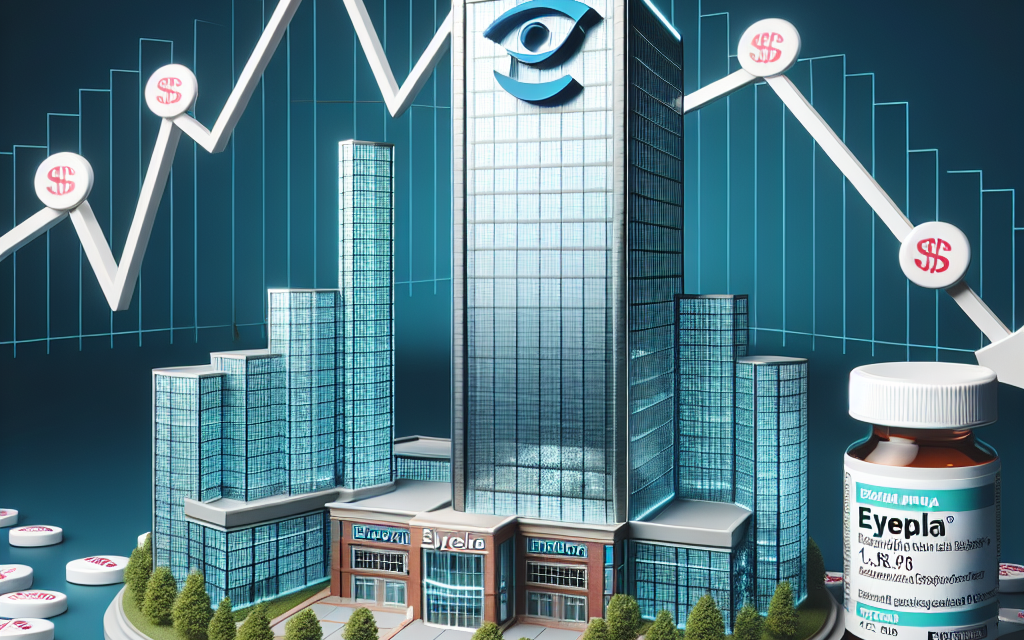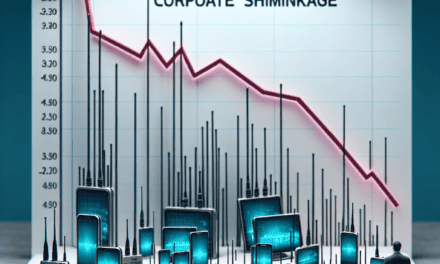“Regeneron Pharmaceuticals: Navigating Challenges as High-Dose Eylea Sales Fall Short.”
Introduction
Regeneron Pharmaceuticals is experiencing a notable decline in its market performance, primarily attributed to disappointing sales figures for its high-dose Eylea treatment. Despite Eylea’s established reputation as a leading therapy for various eye conditions, recent reports indicate that the anticipated surge in demand for the higher dosage has not materialized. This shortfall raises concerns about the company’s growth prospects and highlights the challenges it faces in maintaining its competitive edge in the biopharmaceutical industry. As Regeneron navigates this downturn, stakeholders are closely monitoring the implications for its overall financial health and future product pipeline.
Regeneron’s Eylea Sales: Analyzing the Decline
Regeneron Pharmaceuticals has recently encountered a notable decline in its Eylea sales, particularly concerning the high-dose formulation that was anticipated to bolster the company’s revenue. Eylea, a treatment primarily used for various eye conditions, including age-related macular degeneration and diabetic retinopathy, has been a cornerstone of Regeneron’s portfolio since its approval. However, the latest sales figures indicate a troubling trend that has raised concerns among investors and analysts alike.
The decline in high-dose Eylea sales can be attributed to several factors, including increased competition in the ophthalmology market and evolving treatment paradigms. As new therapies emerge, patients and healthcare providers are presented with alternative options that may offer similar or improved efficacy. This shift in the treatment landscape has led to a decrease in the market share that Eylea once enjoyed. Furthermore, the introduction of biosimilars has intensified the competitive pressure, compelling Regeneron to reassess its pricing strategies and marketing approaches.
In addition to competitive pressures, the overall demand for high-dose Eylea has not met expectations. Initially, the high-dose formulation was projected to capture a significant portion of the market, particularly among patients requiring more frequent dosing. However, the anticipated uptake has been sluggish, leading to a reassessment of the product’s positioning. This underperformance can be linked to a variety of factors, including physician hesitance to switch established patients from their current therapies to a new high-dose regimen, as well as concerns regarding the long-term safety and efficacy of the higher dosage.
Moreover, the broader economic environment has also played a role in the decline of Eylea sales. As healthcare costs continue to rise, payers are increasingly scrutinizing the value of high-cost treatments. This scrutiny has led to more stringent prior authorization requirements and a greater emphasis on cost-effectiveness, which may deter some physicians from prescribing high-dose Eylea. Consequently, Regeneron faces the dual challenge of not only competing with other therapies but also justifying the cost of its product in a market that is becoming increasingly price-sensitive.
In light of these challenges, Regeneron has begun to explore various strategies to revitalize Eylea sales. The company is investing in research and development to enhance the product’s profile and is actively engaging with healthcare providers to better understand their needs and concerns. Additionally, Regeneron is focusing on expanding its marketing efforts to highlight the unique benefits of Eylea, particularly in terms of its established track record and safety profile.
Despite the current decline, it is essential to recognize that Regeneron has a robust pipeline of other products and therapies that may offset the downturn in Eylea sales. The company’s commitment to innovation and its history of successful drug development provide a foundation for potential recovery. As Regeneron navigates this challenging landscape, the focus will likely remain on adapting to market dynamics and leveraging its strengths to maintain its position in the competitive ophthalmology sector.
In conclusion, while Regeneron Pharmaceuticals faces a decline in high-dose Eylea sales due to increased competition, changing treatment paradigms, and economic pressures, the company’s proactive approach to addressing these challenges may pave the way for future success. By continuing to innovate and engage with the medical community, Regeneron can work towards revitalizing its flagship product and ensuring its long-term viability in the market.
Impact of High-Dose Eylea on Regeneron’s Financial Performance
Regeneron Pharmaceuticals, a prominent player in the biopharmaceutical industry, has recently encountered significant challenges that have impacted its financial performance, particularly concerning the sales of its high-dose Eylea formulation. Eylea, a treatment primarily used for various eye diseases, has been a cornerstone of Regeneron’s revenue stream since its launch. However, the anticipated surge in sales from the high-dose version has not materialized as expected, leading to a reevaluation of the company’s financial outlook.
The high-dose Eylea was introduced with the promise of providing enhanced efficacy for patients suffering from conditions such as diabetic macular edema and age-related macular degeneration. Initially, analysts projected that this new formulation would capture a substantial share of the market, potentially driving revenue growth for Regeneron. However, the reality has proven to be more complex. Sales figures for the high-dose Eylea have fallen short of expectations, raising concerns among investors and stakeholders about the sustainability of Regeneron’s revenue model.
One of the primary factors contributing to the disappointing sales is the competitive landscape within the ophthalmology market. Several other pharmaceutical companies have introduced alternative therapies that offer similar benefits, often at lower costs. This increased competition has not only diluted Eylea’s market share but has also pressured Regeneron to reconsider its pricing strategy. As a result, the company has found itself in a precarious position, balancing the need to maintain profitability while also responding to market dynamics that favor more affordable treatment options.
Moreover, the high-dose Eylea’s performance has been further complicated by regulatory scrutiny and evolving clinical guidelines. As healthcare providers increasingly prioritize evidence-based practices, the demand for treatments that demonstrate clear advantages over existing therapies has intensified. Consequently, the high-dose Eylea has faced challenges in establishing its clinical superiority, which is essential for gaining traction among healthcare professionals and patients alike. This situation has led to a stagnation in sales growth, prompting Regeneron to reassess its marketing and educational strategies to better communicate the benefits of the high-dose formulation.
In light of these challenges, Regeneron’s overall financial performance has begun to reflect the struggles associated with high-dose Eylea. The company has reported a decline in revenue, which has raised alarms about its ability to sustain its previous growth trajectory. Investors have responded with caution, leading to fluctuations in stock prices and increased scrutiny of Regeneron’s future prospects. The decline in high-dose Eylea sales has not only affected immediate revenue but has also cast a shadow over the company’s long-term growth potential, as it relies heavily on this product to drive its financial success.
As Regeneron navigates this turbulent period, it is imperative for the company to adapt its strategies in response to the evolving market landscape. This may involve investing in research and development to enhance the efficacy of its products or exploring partnerships that could bolster its competitive position. Additionally, Regeneron must focus on strengthening its relationships with healthcare providers to ensure that the benefits of high-dose Eylea are effectively communicated and understood. Ultimately, the future of Regeneron Pharmaceuticals will depend on its ability to address these challenges and reposition itself within a rapidly changing industry.
Market Competition: How Rivals Are Affecting Eylea Sales
Regeneron Pharmaceuticals has recently encountered a notable decline in its sales of Eylea, particularly in the high-dose segment, a situation that can be attributed to the intensifying competition within the pharmaceutical market. As various companies strive to capture a share of the lucrative ophthalmology market, the competitive landscape has become increasingly challenging for Regeneron. This shift is not merely a reflection of changing consumer preferences but also highlights the strategic maneuvers of rival firms that are introducing innovative therapies aimed at treating similar conditions.
One of the primary competitors in this arena is Bayer, which has partnered with Regeneron in the development and commercialization of Eylea. However, Bayer has also been actively promoting its own products, such as the recently launched Vabysmo, which has garnered attention for its efficacy and dosing regimen. Vabysmo offers a different treatment schedule that appeals to patients and healthcare providers alike, thereby drawing attention away from Eylea. The introduction of such alternatives has created a more fragmented market, where patients are increasingly presented with choices that may better suit their needs, ultimately impacting Eylea’s sales figures.
Moreover, the emergence of biosimilars has further complicated the competitive landscape. As patents for original biologic drugs expire, companies are eager to develop biosimilar versions that can provide similar therapeutic benefits at a lower cost. This trend is particularly relevant in the case of Eylea, as several firms are working on biosimilars that could potentially disrupt Regeneron’s market share. The prospect of more affordable treatment options is likely to sway both patients and healthcare providers, who are often under pressure to manage costs while ensuring effective care.
In addition to these competitive pressures, the overall market dynamics are shifting as well. The increasing prevalence of age-related macular degeneration and other retinal diseases has led to a surge in demand for effective treatments. However, this demand has also attracted new entrants into the market, each vying to establish their own foothold. As a result, Regeneron must not only contend with established competitors but also remain vigilant against emerging players that could further dilute its market position.
Furthermore, the marketing strategies employed by competitors have evolved, leveraging digital platforms and direct-to-consumer advertising to enhance visibility and engagement. This shift in marketing tactics has enabled rival companies to reach potential patients more effectively, thereby increasing their market penetration. Regeneron, while maintaining a strong presence, may need to reassess its own marketing strategies to ensure that Eylea remains top-of-mind for both patients and healthcare providers.
As Regeneron navigates this increasingly competitive environment, it is essential for the company to innovate and adapt. This may involve investing in research and development to enhance Eylea’s formulation or exploring new indications that could broaden its therapeutic applications. Additionally, strengthening partnerships and collaborations could provide Regeneron with the necessary resources to bolster its competitive edge.
In conclusion, the decline in Eylea sales is a multifaceted issue influenced by the growing competition from both established and emerging players in the market. As rivals continue to innovate and capture the attention of patients and healthcare providers, Regeneron must strategically respond to these challenges to maintain its position in the ophthalmology market. The ability to adapt to these competitive pressures will be crucial for Regeneron as it seeks to navigate the complexities of the pharmaceutical landscape and sustain its growth in the face of evolving market dynamics.
Future Prospects for Regeneron Pharmaceuticals
Regeneron Pharmaceuticals, a prominent player in the biopharmaceutical industry, is currently navigating a challenging landscape marked by disappointing sales of its high-dose Eylea formulation. This situation raises critical questions about the company’s future prospects and its ability to sustain growth in an increasingly competitive market. Eylea, a treatment for various eye diseases, has been a cornerstone of Regeneron’s revenue stream. However, recent reports indicate that the anticipated surge in sales from the high-dose version has not materialized as expected. This decline in performance could have significant implications for the company’s financial health and strategic direction.
As Regeneron looks ahead, it must address the factors contributing to the underwhelming sales figures. One potential reason for the lackluster performance could be the emergence of alternative therapies that offer similar benefits with fewer injections or side effects. The competitive landscape in ophthalmology is evolving rapidly, with several companies developing innovative treatments that challenge Eylea’s market dominance. Consequently, Regeneron may need to invest in research and development to enhance the efficacy and appeal of its products, ensuring they remain relevant in a crowded marketplace.
Moreover, the company faces the challenge of maintaining its robust pipeline of drug candidates. While Regeneron has historically been successful in bringing new therapies to market, the pressure to deliver breakthrough treatments is intensifying. Investors and stakeholders are keenly aware that the success of future products will be crucial in offsetting any revenue declines from Eylea. Therefore, Regeneron must prioritize its research initiatives and consider strategic partnerships or acquisitions that could bolster its portfolio and accelerate the development of promising therapies.
In addition to focusing on its pipeline, Regeneron should also consider enhancing its marketing strategies to better communicate the benefits of Eylea, particularly the high-dose formulation. Effective marketing can play a pivotal role in influencing physician prescribing habits and patient adherence to treatment regimens. By emphasizing the unique advantages of Eylea, such as its proven efficacy and safety profile, Regeneron may be able to regain market share and stimulate demand for its products.
Furthermore, the company should remain vigilant regarding regulatory developments and reimbursement policies that could impact its operations. Changes in healthcare regulations or shifts in insurance coverage can significantly affect the accessibility and affordability of treatments, ultimately influencing sales performance. By proactively engaging with policymakers and payers, Regeneron can advocate for favorable conditions that support the continued use of its therapies.
Looking ahead, Regeneron Pharmaceuticals has the potential to rebound from its current challenges, but this will require a multifaceted approach. By investing in innovation, refining marketing strategies, and navigating the regulatory landscape effectively, the company can position itself for future success. While the decline in high-dose Eylea sales is concerning, it also presents an opportunity for Regeneron to reassess its strategies and adapt to the evolving needs of the market. Ultimately, the company’s ability to leverage its strengths and address its weaknesses will determine its trajectory in the coming years. As the biopharmaceutical industry continues to evolve, Regeneron must remain agile and responsive to ensure it remains a leader in the field, capable of delivering innovative solutions that meet the needs of patients and healthcare providers alike.
Investor Reactions to Eylea Sales Decline
Regeneron Pharmaceuticals has recently encountered a significant decline in its stock value, primarily attributed to disappointing sales figures for its high-dose Eylea treatment. This development has prompted a wave of reactions from investors, who are increasingly concerned about the future prospects of the company. Eylea, a drug used to treat various eye conditions, has been a cornerstone of Regeneron’s revenue stream. However, the recent sales figures have raised alarms, leading to a reevaluation of the company’s growth trajectory.
As investors digested the news of Eylea’s underperformance, many expressed their apprehensions regarding Regeneron’s ability to maintain its competitive edge in the biopharmaceutical market. The high-dose version of Eylea was anticipated to bolster sales, particularly as it was positioned to address a growing patient population. However, the lackluster uptake of this formulation has led to questions about the drug’s market viability and the effectiveness of Regeneron’s marketing strategies. Consequently, investors are now scrutinizing the company’s pipeline of products, seeking reassurance that other potential revenue sources can compensate for the shortfall in Eylea sales.
Moreover, the decline in Eylea sales has sparked discussions about the broader implications for Regeneron’s financial health. Analysts have begun to adjust their forecasts, reflecting a more cautious outlook on the company’s earnings potential. This shift in sentiment is evident in the stock market, where Regeneron’s shares have experienced volatility as investors react to the evolving narrative surrounding Eylea. The uncertainty surrounding the drug’s performance has led to a reevaluation of the company’s valuation, with some investors opting to divest their holdings in favor of more stable opportunities.
In addition to concerns about Eylea, investors are also paying close attention to the competitive landscape within the ophthalmology market. The emergence of alternative therapies and biosimilars poses a significant threat to Regeneron’s market share. As competitors introduce innovative treatments, the pressure mounts on Regeneron to not only enhance the performance of Eylea but also to accelerate the development of its pipeline candidates. This competitive dynamic has further fueled investor anxiety, as the potential for market erosion becomes increasingly tangible.
Furthermore, the investor community is keenly aware of the importance of effective communication from Regeneron’s management team. Transparency regarding the challenges faced by Eylea and the strategic initiatives being implemented to address these issues is crucial in restoring investor confidence. As the company navigates this turbulent period, stakeholders are looking for clear guidance on how Regeneron plans to adapt to the changing market conditions and leverage its research capabilities to drive future growth.
In conclusion, the decline in high-dose Eylea sales has elicited a multifaceted response from investors, who are grappling with concerns about Regeneron’s financial outlook and competitive positioning. As the company faces these challenges, it must not only address the immediate issues surrounding Eylea but also articulate a compelling vision for its future. The ability to reassure investors through strategic initiatives and transparent communication will be pivotal in determining Regeneron’s trajectory in the coming months. Ultimately, the path forward will require a delicate balance of innovation, market responsiveness, and stakeholder engagement to navigate the complexities of the biopharmaceutical landscape.
Regulatory Challenges Facing Regeneron and Eylea
Regeneron Pharmaceuticals, a prominent player in the biopharmaceutical industry, is currently navigating a challenging landscape marked by regulatory hurdles that have significantly impacted its flagship product, Eylea. This drug, primarily used for treating various eye conditions, has been a cornerstone of Regeneron’s revenue stream. However, recent developments surrounding high-dose Eylea have raised concerns among investors and stakeholders alike. The decline in sales of this higher dosage formulation can be attributed to a combination of regulatory challenges and market dynamics that have created a perfect storm for the company.
To begin with, the regulatory environment surrounding pharmaceuticals is inherently complex and can often be unpredictable. In the case of Eylea, Regeneron has faced scrutiny from regulatory bodies regarding the safety and efficacy of the high-dose formulation. While the standard dose of Eylea has been well-established and widely accepted, the introduction of a higher dosage has prompted questions about its long-term effects and potential risks. Regulatory agencies, including the U.S. Food and Drug Administration (FDA), have a mandate to ensure that any new formulation meets stringent safety standards before it can be marketed. Consequently, this has led to delays in approvals and a cautious approach from healthcare providers, who may be hesitant to adopt a new treatment regimen without robust clinical data supporting its use.
Moreover, the competitive landscape for eye treatments has intensified, further complicating Regeneron’s position. Several other pharmaceutical companies are actively developing alternative therapies that target similar conditions, which has led to increased scrutiny of Eylea’s market share. As new entrants emerge, the pressure on Regeneron to demonstrate the superiority of high-dose Eylea becomes more pronounced. This competitive dynamic is exacerbated by the fact that many healthcare providers are reluctant to switch to a new treatment without compelling evidence of its benefits over existing options. As a result, the uptake of high-dose Eylea has been slower than anticipated, contributing to the overall decline in sales.
In addition to these challenges, Regeneron must also contend with the broader implications of healthcare policy and reimbursement practices. Changes in insurance coverage and reimbursement rates can significantly influence the adoption of new therapies. If high-dose Eylea does not receive favorable reimbursement status, healthcare providers may be less inclined to prescribe it, further hindering its market penetration. This situation underscores the importance of not only regulatory approval but also the economic viability of new treatments in a rapidly evolving healthcare landscape.
Furthermore, the ongoing scrutiny of drug pricing and the push for more affordable healthcare solutions have placed additional pressure on pharmaceutical companies, including Regeneron. As public sentiment shifts towards demanding lower drug prices, companies must navigate the delicate balance between innovation and affordability. This environment can create additional regulatory challenges, as policymakers may impose stricter guidelines on pricing and access to new therapies.
In conclusion, Regeneron Pharmaceuticals is currently facing a multifaceted set of regulatory challenges that are impacting the sales of high-dose Eylea. The interplay of regulatory scrutiny, competitive pressures, and evolving healthcare policies has created a complex landscape for the company. As Regeneron seeks to address these challenges, the future of Eylea and its role in the company’s portfolio remains uncertain. The path forward will require strategic navigation of these regulatory hurdles while continuing to innovate and respond to market demands.
Strategies for Regeneron to Revive Eylea Sales
Regeneron Pharmaceuticals is currently navigating a challenging landscape, particularly in light of disappointing sales figures for its high-dose Eylea formulation. As the company seeks to revitalize its flagship product, it must consider a multifaceted approach that addresses both market dynamics and patient needs. One of the primary strategies Regeneron could employ is enhancing its marketing efforts to better communicate the benefits of high-dose Eylea to healthcare providers and patients alike. By focusing on the unique advantages of the high-dose formulation, such as potentially fewer injections and improved patient outcomes, Regeneron can create a compelling narrative that resonates with both physicians and patients.
In addition to bolstering marketing initiatives, Regeneron should also invest in educational programs aimed at ophthalmologists and other healthcare professionals. These programs could provide in-depth information about the clinical data supporting high-dose Eylea, thereby equipping doctors with the knowledge they need to make informed treatment decisions. By fostering a deeper understanding of the product’s efficacy and safety profile, Regeneron can encourage more physicians to consider high-dose Eylea as a viable treatment option for their patients.
Moreover, Regeneron could explore partnerships with patient advocacy groups to raise awareness about the importance of effective treatment options for retinal diseases. Collaborating with these organizations can help amplify the message about high-dose Eylea and its potential benefits, ultimately driving patient demand. Engaging with patients directly through outreach initiatives can also provide valuable insights into their preferences and concerns, allowing Regeneron to tailor its strategies more effectively.
Another avenue for Regeneron to consider is expanding its clinical trial programs to investigate additional indications for high-dose Eylea. By exploring new therapeutic areas, the company can potentially unlock new revenue streams and broaden its market reach. This approach not only demonstrates Regeneron’s commitment to innovation but also positions the company as a leader in the field of ophthalmology. Furthermore, successful trials could generate positive publicity and enhance the overall perception of the Eylea brand.
In addition to these proactive measures, Regeneron should also focus on optimizing its supply chain and distribution channels to ensure that high-dose Eylea is readily available to patients. Streamlining logistics and addressing any potential barriers to access can significantly impact sales performance. By ensuring that healthcare providers have easy access to the product, Regeneron can facilitate timely treatment for patients, thereby improving overall satisfaction and adherence to therapy.
Lastly, Regeneron must remain vigilant in monitoring market trends and competitor activities. By staying attuned to the evolving landscape of ophthalmic treatments, the company can adapt its strategies accordingly. This agility will be crucial in maintaining a competitive edge and ensuring that high-dose Eylea remains a relevant option in the marketplace.
In conclusion, while Regeneron Pharmaceuticals faces challenges with its high-dose Eylea sales, a comprehensive strategy that includes enhanced marketing, educational initiatives, partnerships with advocacy groups, expanded clinical trials, optimized distribution, and market vigilance can pave the way for a successful revival. By addressing the needs of both healthcare providers and patients, Regeneron can not only improve sales figures but also reinforce its commitment to advancing treatment options in the field of ophthalmology.
Q&A
1. **What is the main reason for Regeneron Pharmaceuticals’ decline?**
– The decline is primarily due to disappointing sales of high-dose Eylea.
2. **What is Eylea used for?**
– Eylea is used to treat various eye conditions, including age-related macular degeneration and diabetic retinopathy.
3. **How did high-dose Eylea sales perform compared to expectations?**
– High-dose Eylea sales fell short of market expectations, leading to concerns about future revenue.
4. **What impact did the sales decline have on Regeneron’s stock?**
– The disappointing sales contributed to a decrease in Regeneron’s stock price.
5. **What are analysts saying about Regeneron’s future prospects?**
– Analysts are cautious, suggesting that the decline in Eylea sales could impact Regeneron’s growth trajectory.
6. **Are there any new treatments in Regeneron’s pipeline?**
– Yes, Regeneron has several treatments in development, but their success is uncertain.
7. **What strategies might Regeneron employ to address the sales decline?**
– Regeneron may focus on enhancing marketing efforts, exploring new indications for Eylea, or accelerating the development of pipeline products.
Conclusion
Regeneron Pharmaceuticals is experiencing a decline in its market performance due to disappointing sales of its high-dose Eylea treatment, which has not met expectations. This shortfall raises concerns about the company’s growth prospects and highlights the challenges it faces in maintaining its competitive edge in the ophthalmology market. The situation underscores the importance of innovation and effective market strategies for sustaining revenue in the pharmaceutical industry.





